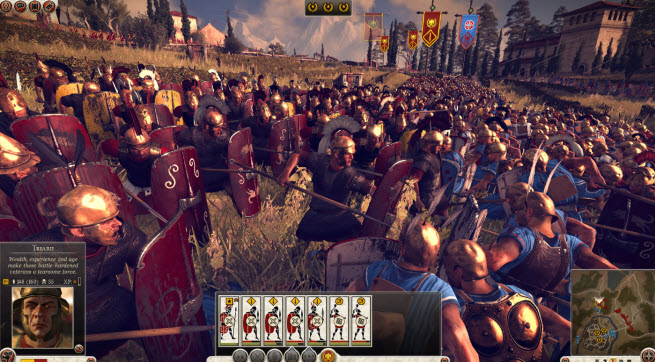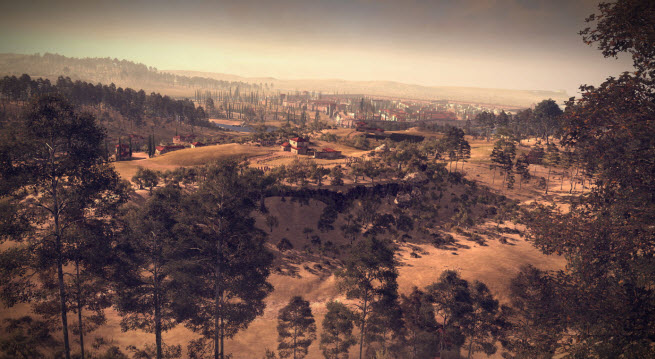Few games can capture everything from the raw emotions of the battlefield to a bird’s-eye view of a grand imperial chess game as well as Total War: Rome II, a new PC game coming on Sept. 3 from Sega. I believe that this title takes strategy gaming to a new level of quality.
This latest game in developer The Creative Assembly’s long-running Total War series is going to be the best yet, based on my hands-on preview of the game. This game combines real-time strategy combat with a Civilization-style grand campaign that tracks your progress as you expand the boundaries of Rome. You can view the strategic shifts across the whole of North Africa or view your progress as a general sitting on a horse on a hill overlooking a giant battle.
This game is massive, with a campaign map that is four times larger in scope than the previous Total War: Shogun 2 game from 2011. It will feed a hungry base of fans. Last year, even without a major release, the Total War series sold more than 2 million copies and 5 million expansion packs. That tells you there should be a lot of pent-up demand for the biggest game in the series yet.
Sega is publishing the PC game, and developer The Creative Assembly recently let the press in for some hands-on combat. I took command of the empire as the Roman general Gaius Fulvius, fighting a couple of battles in the early days of the Roman empire, when the city-state of Rome was squaring off against the nearby Samniums. As I noted before in an earlier preview, this game is going to steal a lot of time from me and other strategy fans.
The new graphics engine can support animations of colossal battles, with armies and individual units rendered in incredible detail. You can see the battle from one soldier’s point of view or scale up far above the battle.
Al Bickham, the studio communications manager at The Creative Assembly, said in an interview that it is “the most ambitious game we have ever made.” A new trailer shows off the different scenarios, which can range from Scotland to the Horn of Africa. In the trailer, the clueless Roman Senate debates where its Carthaginian enemies are. All the while, Hannibal is leading his war elephants and army over the Alps.
The campaign map
In the game, the campaign map is wonderful to look at. You can view the richly detailed terrain and explore regions from above. You can scroll over the territories and get information about the region, such as resources and armed forces. Armies are represented via leaders who stand up as 3D objects on the map. You can click on cities and start building, or you can take command of a leader and move his army to a strategic spot on the map. When you meet the enemy in battle, the game zooms down to a map of the actual battlefield. There, you set up your troops in formation and then begin a real-time battle. The standard view is from above, so you can see your legions in formation. But once the battle commences, you can zoom down level with the soldiers.
The campaign map is what you’ll use when you’re making decisions about what technology to research or how to expand your military and develop new kinds of weapons. Advisers can tell you what kind of matters need your attention. The map also shows at a glance how many regions you command compared to your enemies. You’ll see who your biggest threat is. You can form diplomatic or political alliances to head off those emerging threats. But the artificial intelligence of your rivals will figure out if your empire needs to be encircled or taken down a notch.
The game starts out in 272 B.C. There are nine factions in the game, with more than 700 different army units, compared to just 50 in Total War: Shogun 2.
The Samnium campaign
The game has some strong storytelling, giving you a feel for the stakes at hand as you deal with the enemy threat. I started out at the siege of Capua, Italy. The Samnium War wasn’t going well, and I had to march my Romans to a city and rescue a Roman army. My first task was to send my troops through the woods and take control of a village. My troops outnumbered and outfought the Samniums. Then I had to march my soldiers through the woods on a hill and attack the Samnite catapults from the flanks. I picked up more units as I proceeded, and then I had to rush my troops across a river and head off the final Samnite assault on the city.
The battle was easy to win. I simply had to remember to send two army groups against a lone enemy, surrounding it and hitting it from the flanks. That caused the enemies to break and run away in a panic. The Samnites then launched a full-scale assault across the bridges. But I was rescued in the nick of time as a contingent of reinforcements arrived. It was hairy, roller-coaster experience. I was ecstatic when my defenses held up.
With the next encounter, I had to go out to the campaign map and set up defenses for the region of Campania, which was on the way to Rome and Capua. The Samnites were preparing an invasion, and I had to create more army units to fend off the invaders. Finally, we gathered for the Battle of Vesuvius in a mountain pass. In that battle, my forces were arrayed to guard a plain near my fort. The enemy started advancing against my soldiers, but I had a few units of cavalry hidden in the woods on a big hill on my right flank. When the enemy engaged me, I sent the cavalry down the hill to smash into the flanks.
I had to restart the battle a couple of times because I kept forgetting to protect my general, who kept dying in the cavalry charges. I enjoyed going from the bird’s-eye view to the soldiers’ perspective as my infantry smashed into the rivals. The individual soldier animations aren’t perfect, but they convey the desperate nature of the battle. Overall, the rock-paper-scissors basics of military tactics will serve you well. It pays to flank the enemy. Spearmen will stop a cavalry charge cold. And making the enemy panic is the sure way to victory.
Much like in Civilization, you can play for an economic or cultural victory. You can set up trade agreements. War is the swift way to win, but it earns you enemies who can stop you cold before you become too powerful.
The game is a big improvement upon Shogun in a number of ways. You can fight in cities in a more realistic way. Your soldiers can fight in the streets, alleys, squares, and walls. Some of the cities will be huge with kilometers of high walls. You can attack using both land forces and a fleet of troop transports at the same time. It’s fun to watch the grand battles unfold as thousands of troops take each other on. But beware. If you give the wrong commands, it’s hard for your troops to recover from them. Nothing is worse than seeing your line break and start to run away from the enemy. When they’re that spooked, there is nothing you can do to turn them around.
The attention to detail in this game is first rate. I’m looking forward to playing it and conquering the known world.
VentureBeat's mission is to be a digital town square for technical decision-makers to gain knowledge about transformative enterprise technology and transact. Learn More



